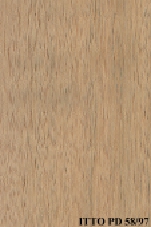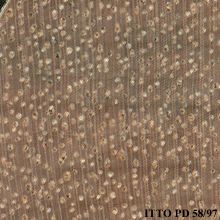
ADJOUABA (Dacryodes klaineana)
Trade Name
Adjouaba
Scientific Name
Dacryodes klaineana H.J.Lam
Family
BURSERACEAE
Common Names
Orumu egbo (Nigeria); Adjouaba (Côte d`Ivoire); Nom ebap (Gabon); Abatom (Gabon); Nom ebap (Cameroon); Adjouaba (Cameroon); Adjouaba
Description Of The Tree
Botanical Description
The tree reaches a height of 23 to 26 m. The trunk diameter attains 70 to 130 cm. The bole has an irregular shape, with poorly developed buttresses, or wide spreading superficial roots.
Natural Habitat
Dacryodes klaineana is prevalent in deciduous, dry deciduous and fringing forests, also in high plateaus along rivers and in coastal forests.
Natural Distribution
West Africa.
Wood Identification
Anatomic Description Of Wood
Vessels per mm2 10 to 20 (abundant). Wood diffuse porous. Vessels solitary and in short radial multiples. Tyloses common. Tangential diameter of vessel lumina 150 to 200 micras (medium). Vessel-ray pits larger than the intervessel pits. Simple perforation plate Axial parenchyma absent or extremely rare, non visible with magnifying glass (8x). Occasionally siliceous bodies in the axial parenchyma. 4 to 10 rays per mm (medium). Rays commonly 2 seriate. Silica bodies in the ray cells. Non-crystals in ray cells. Non-septate fibers. Fibers with simple to minutely bordered pits.
-
 Wood Macro Photo Tangential Plane
Wood Macro Photo Tangential Plane
-
 Wood Micro Photo Of Transversal Section
Wood Micro Photo Of Transversal Section
Availability
Cites Status
Unrestricted
General Wood Description
Color
The sapwood is paler than the heartwood. The heartwood is grey or pink, it is clearly demarcated.
Grain
It has highly interlocked grain; special care is needed when drying because of frequent risks of distortion.
Texture
This species is usually reported to have a fine texture.
Luster
The wood surface is described as low in luster.
Natural Durability
Not durable; important risks of decay attacks at any processing step, from logs up to final products. It must receive preservative treatment. Resistant to termites attack.
Natural durability index (1= Very high durability, 7=Vey low durability)
5
Internal Growth Stresses
Residual stresses are reported to be absent.
Silica Content
Silica Content: Silica presence is reported. Amounts over 0.05% may affect wood processing. Silica Value: 0.17
Resistance To Impregnation
Nearly impossible to treat with a too much low penetration of the preservative substances.
Wood Physical Properties
Basic Density or Specific Gravity (O.D. weight/vol. green) (g/cm³)
0.72
Air-dry Density (Weight and volume at 12%MC) (g/cm³)
0.81
Total shrinkage Tangential (Saturated to 0%MC) (%)
9.4
Total shrinkage Radial (Saturated to 0%MC) (%)
6.1
Drying Defects
Ease of Drying: Mersawa air dries very slowly with slight seasoning defects. Boards of 25 mm thick take 7.5 months to air dry. Drying Defects: Cupping and bowing are recorded. Kiln Schedules: Kiln drying is slow but without degrade, although the core of logs of old trees tends to retain a high moisture content.
Recommended Dry Kiln Schedule
FR-8
Dimensional stability ratio (Total Tangential Shrinkage %/Total Radial Shrinkage %)
1.5
Wood Chemical Properties
Wood Mechanical Properties
Bending Strength (MOR),12%MC (kgf/cm²)
1248
Stiffness (MOE) 12%MC (kgf/cm²)
200877
Compression parallel to fiber 12%MC (kgf/cm²)
671
Compression perpendicular to fiber 12%MC (kgf/cm²)
92
Shear strength radial 12%MC (kgf/cm²)
116
Janka hardness (side) 12%MC (kgf)
813
Janka hardness (end grain) 12%MC (kgf)
887
Workability
Sawing
Sawing of this species requires powerful equipment.
Rotary Veneer Cutting
Not suitable for veneering.
Sliced Veneer
Not suitable for veneering.
Blunting Effect
Severe blunting effect; stellited blades for sawing and carbide tools for machining are recommended.
Machining
It needs powerful tools for processing. Possible difficulties caused by interlocked grain are reported.
Planing
Moderately easy; tools must be cautiously sharpened.
Moulding
Moderately easy; tools must be cautiously sharpened.
Turning
30
Boring
Moderately easy; tools must be cautiously sharpened.
Mortising
Moderately easy; tools must be cautiously sharpened.
Nailing
Pre-boring is necessary.
Gluing
Difficult to glue because of high density.
Sanding
Easy to perform; it gives good results.
Polishing
Can be polished without surface preparation.
Response To Hand Tools
Working with hand tools is difficult.
REFERENCED USES
End Uses Summary
HOUSING GENERAL, flooring, parquet, fittings, FURNITURE AND CABINETS, cabinets, PLYWOOD AND VENEER, TURNING, SPORTS, TOOLS, tool handles, agricultural tools, CONTAINERS, truck bodies, truck flooring, NAVAL CONSTRUCTION, boats
General Housing
- 10 - Silica in Timbers
Flooring
- 14 - Handbook of Hardwoods
Parquet
- 15 - Empire Timbers
Fittings
- 19 - Silica in Timbers
Furniture Cabinets
- 21 - Tropical timbers of the world. Part III-Southeast Asian and Oceanian Species.
Cabinet
- 24 - Empire Timbers
Panels, Veneers
- 25 - Directory of Timber Trade Malaysia
Turning
- 30 - Embassy of Honduras in Japan
Sports
- 38 - Annual Review and Assessment of the World Timber Situation 1998-ITTO
Tools
- 42 - Utilización Industrial de Nuevas Especies Forestales en el Perú.
Tool Handles
- 43 - Maderas de Bolivia (Características y Usos de 55 Maderas Tropicales)
Agricultural Tools
- 44 - Atlas of Peruvian Woods
Truck Body
- 53 - Timbers of the New World
Truck Flooring
- 54 - Bulletin of the Government Forest Experiment Station N.157: Identification of Tropical Woods
Shipbuilding
- 55 - Tropical Timber Atlas of Latin America
Boats
- 56 - Manual de Identificación de Especies Forestales de la Subregión Andina.
Please Provide Information To View Producer Information